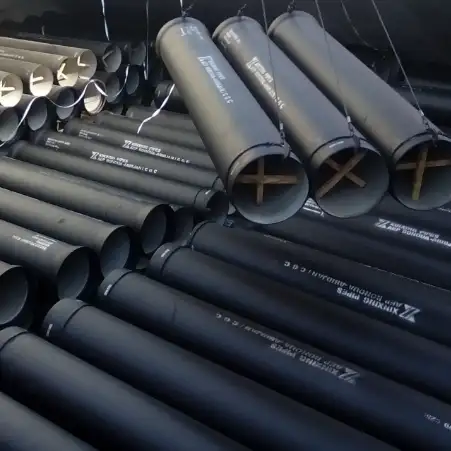ASTM A536 Grade 70-50-05 is a high-strength ductile iron (also known as nodular or spheroidal graphite iron) with excellent mechanical properties, including a tensile strength of 70 ksi (485 MPa), yield strength of 50 ksi (345 MPa), and 5% elongation. This grade is widely used in automotive, agricultural, and industrial applications due to its superior ductility, impact resistance, and machinability. Its unique microstructure, featuring spherical graphite nodules, enhances durability and fatigue resistance.

1. Introduction to ASTM A536 Grade 70-50-05
ASTM A536 Grade 70-50-05 is a specification for ductile iron castings, also known as spheroidal graphite (SG) iron. This grade is characterized by its combination of high tensile strength and moderate elongation, making it suitable for applications where strength is paramount, but some degree of ductility is still required.
The designation “70-50-05” refers to the minimum mechanical properties of the material:
-
70: Minimum tensile strength of 70,000 psi (approximately 485 MPa)
-
50: Minimum yield strength of 50,000 psi (approximately 345 MPa)
-
05: Minimum elongation of 5% in 2 inches (50 mm)
These properties are achieved through precise control of the casting process and the chemical composition of the alloy.
2. Chemical Composition
While ASTM A536 does not specify exact chemical compositions, it provides guidelines for the typical range of elements found in Grade 70-50-05 ductile iron:
-
Carbon (C): 3.40% to 3.80%
-
Silicon (Si): 2.20% to 2.80%
-
Manganese (Mn): 0.20% to 0.80%
-
Phosphorus (P): ≤ 0.08%
-
Sulfur (S): ≤ 0.02%
-
Magnesium (Mg): 0.03% to 0.05% (added to promote spheroidal graphite formation)
The precise balance of these elements is crucial in achieving the desired mechanical properties and microstructure.
3. Mechanical Properties
Grade 70-50-05 ductile iron exhibits the following mechanical properties:
-
Tensile Strength: Minimum 70,000 psi (485 MPa)
-
Yield Strength: Minimum 50,000 psi (345 MPa)
-
Elongation: Minimum 5% in 2 inches (50 mm)
-
Brinell Hardness: 160 to 210 HB
-
Elastic Modulus: Approximately 180 GPa
-
Shear Strength: Approximately 450 MPa
These properties make it suitable for applications requiring a balance between strength and ductility.
4. Microstructure and Matrix Structure
The microstructure of ASTM A536 Grade 70-50-05 ductile iron consists primarily of spheroidal graphite nodules embedded in a matrix of ferrite and pearlite. The proportion of ferrite to pearlite can be controlled during the casting process to achieve the desired balance of strength and ductility.
The spheroidal graphite structure imparts enhanced mechanical properties compared to traditional gray cast iron, including improved impact resistance and fatigue strength.
5. Heat Treatment and Processing
Grade 70-50-05 ductile iron can be heat-treated to further enhance its properties:
-
Stress Relieving: Performed to reduce internal stresses after casting.
-
Annealing: Used to soften the material and improve machinability.
-
Normalizing: Helps to refine the grain structure and improve uniformity.
-
Austempering: A heat treatment process that can increase strength and wear resistance.
The choice of heat treatment depends on the specific requirements of the application.
6. Applications
ASTM A536 Grade 70-50-05 ductile iron is utilized in various applications, including:
-
Automotive Components: Engine blocks, crankshafts, and suspension components.
-
Industrial Machinery: Gearboxes, flywheels, and pump housings.
-
Piping Systems: Fittings and valves for water and gas distribution.
-
Construction Equipment: Parts subjected to high stress and wear.
Its combination of strength and moderate ductility makes it suitable for components subjected to dynamic loads and varying stress conditions.
7. Comparative Analysis with Other Ductile Iron Grades
| Grade | Tensile Strength (psi) | Yield Strength (psi) | Elongation (%) | Hardness (HB) |
|---|---|---|---|---|
| 70-50-05 | 70,000 | 50,000 | 5 | 160-210 |
| 80-60-03 | 80,000 | 60,000 | 3 | 180-230 |
| 100-70-03 | 100,000 | 70,000 | 3 | 200-250 |
| 120-90-02 | 120,000 | 90,000 | 2 | 220-270 |
Grade 70-50-05 offers a balance between strength and ductility, making it suitable for applications where moderate elongation is acceptable. Higher grades like 80-60-03 and 100-70-03 provide increased strength but at the expense of reduced elongation.
8. Global Equivalents
ASTM A536 Grade 70-50-05 ductile iron corresponds to the following international standards:
-
ISO 500-7
-
EN-JS 1050
-
DIN GGG50
-
BS 500/7
-
GB QT500-7
-
JIS FCD500
These equivalents ensure that the material meets similar mechanical properties and performance criteria across different regions.
9. Frequently Asked Questions (FAQs)
Q1: What is the significance of the “70-50-05” designation?
The “70-50-05” designation refers to the minimum mechanical properties of the material: 70,000 psi tensile strength, 50,000 psi yield strength, and 5% elongation in 2 inches. This system provides a standardized way to specify the material’s performance characteristics.
Q2: How does ASTM A536 Grade 70-50-05 compare to other ductile iron grades?
Compared to other grades, 70-50-05 offers a balance between strength and ductility. Higher grades like 80-60-03 and 100-70-03 provide increased strength but with reduced elongation, making them suitable for applications requiring higher strength but less flexibility.
Q3: Can ASTM A536 Grade 70-50-05 be heat-treated?
Yes, Grade 70-50-05 can undergo various heat treatments such as stress relieving, annealing, normalizing, and austempering to enhance its properties. The choice of heat treatment depends on the specific requirements of the application.
Q4: What are the typical applications of ASTM A536 Grade 70-50-05?
This grade is used in automotive components, industrial machinery, piping systems, and construction equipment, particularly for parts subjected to dynamic loads and varying stress conditions.
Q5: Are there any international equivalents to ASTM A536 Grade 70-50-05?
Yes, international equivalents include ISO 500-7, EN-JS 1050, DIN GGG50, BS 500/7, GB QT500-7, and JIS FCD500, ensuring consistent performance characteristics across different regions.
Q6: How does the chemical composition affect the properties of ASTM A536 Grade 70-50-05?
The chemical composition, including elements like carbon, silicon, manganese, phosphorus, sulfur, and magnesium, influences the material’s microstructure and, consequently, its mechanical properties. Precise control of these elements is essential to achieve the desired balance of strength and ductility.
